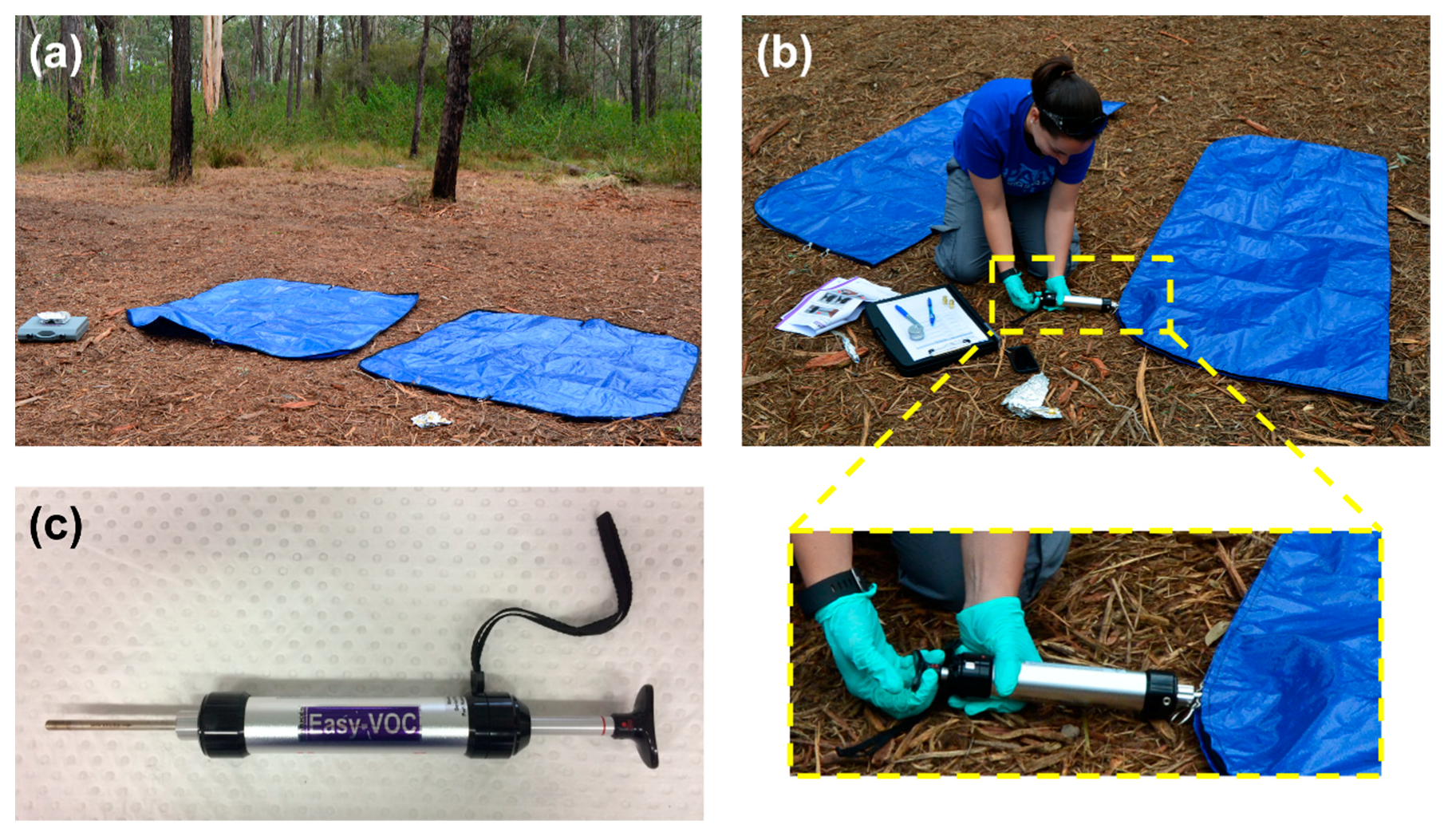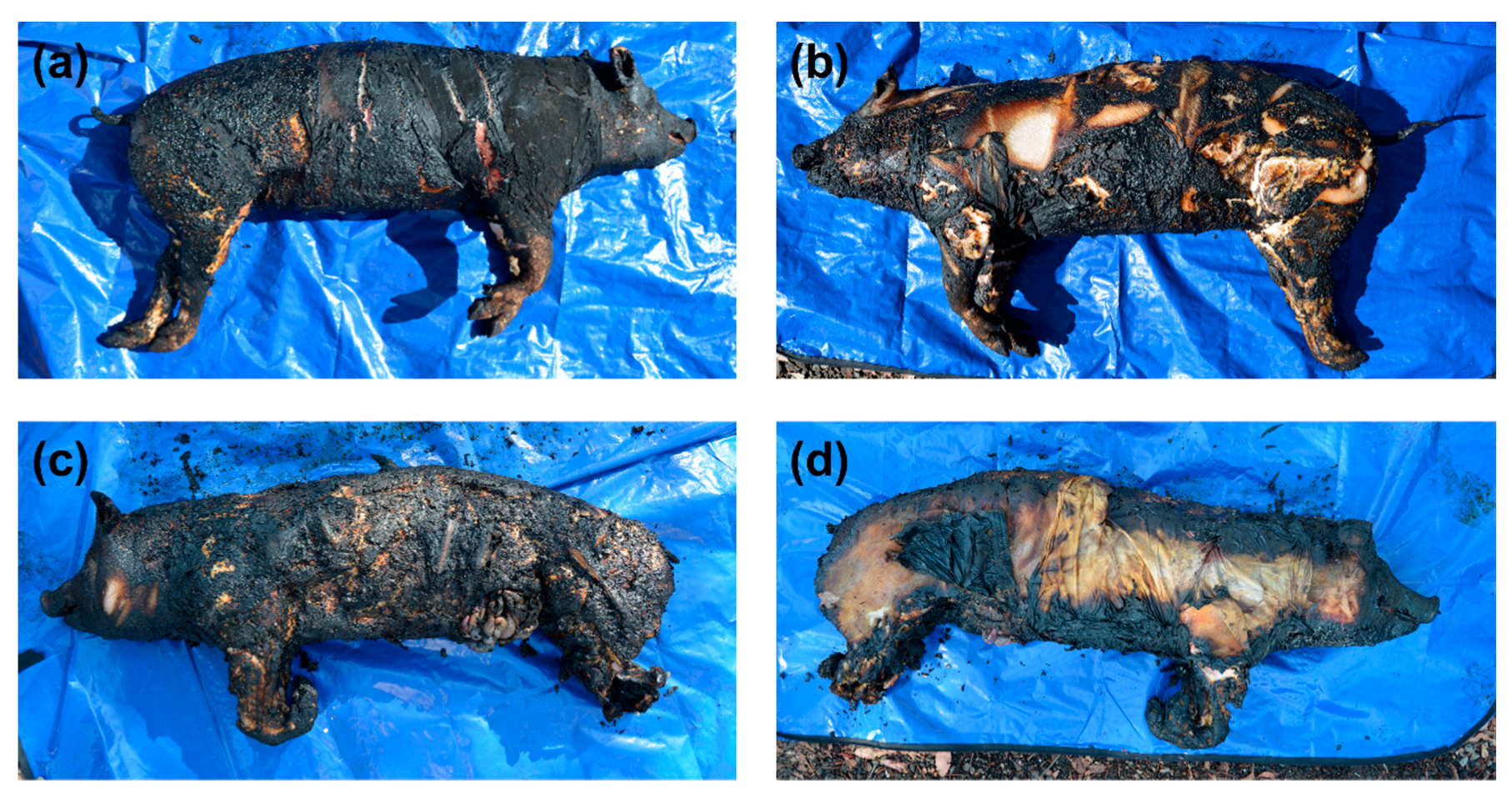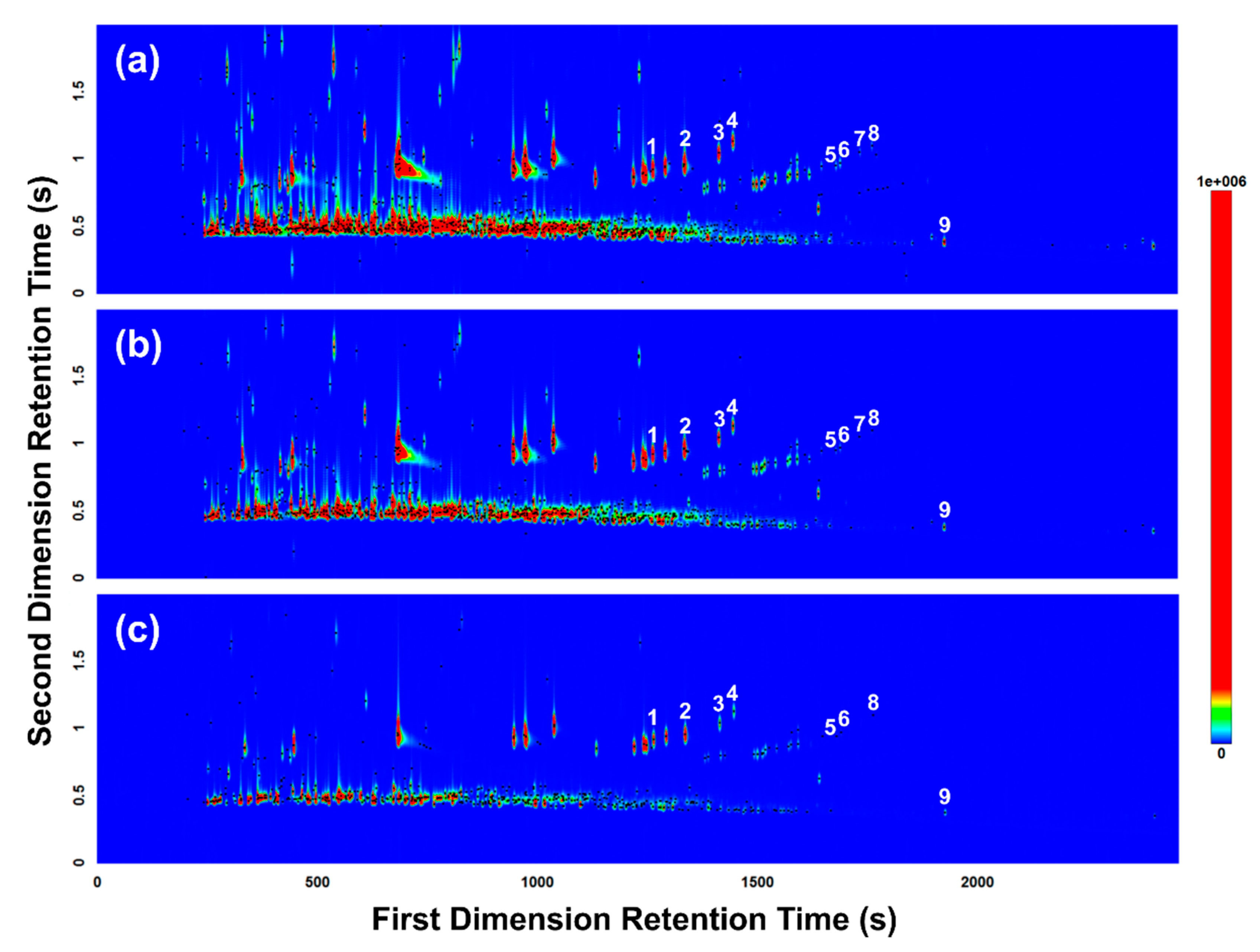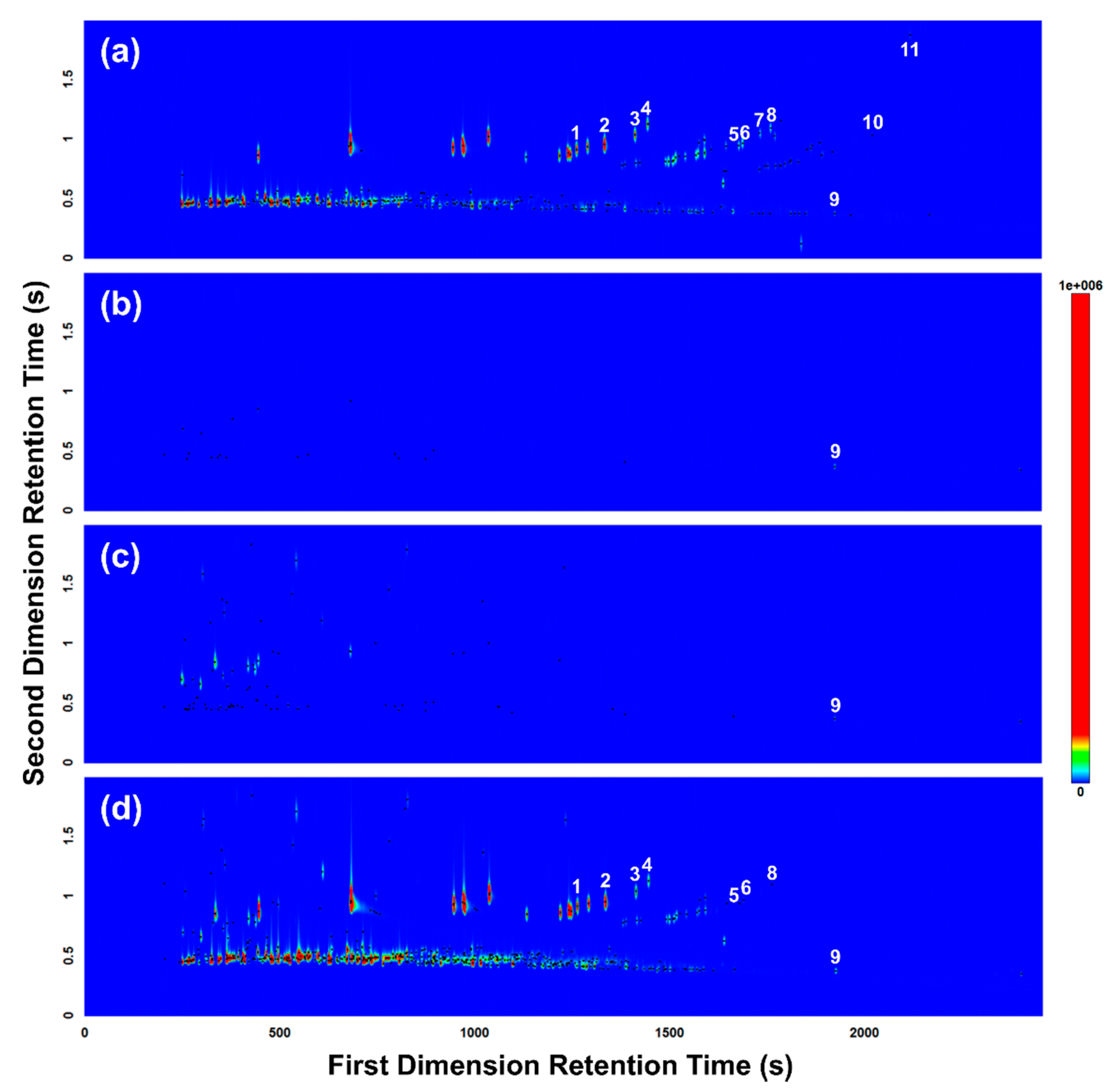Developing a Method for the Collection and Analysis of Burnt Remains for the Detection and Identification of Ignitable Liquid Residues Using Body Bags, Dynamic Headspace Sampling, and TD-GC×GC-TOFMS
Abstract
:1. Introduction
2. Materials and Methods
2.1. Experimental Design
2.2. Sample Collection
2.3. TD-GC×GC-TOFMS Analysis
2.4. Data Processing
3. Results and Discussion
3.1. Experimental Burn Conditions and Observations
3.2. Sample Collection Method
3.3. Sample Analysis
3.4. Multivariate Data Analysis
4. Conclusions
Author Contributions
Funding
Acknowledgments
Conflicts of Interest
References
- Sinkov, N.A.; Sandercock, P.M.L.; Harynuk, J.J. Chemometric classification of casework arson samples based on gasoline content. Forensic Sci. Int. 2014, 235, 24–31. [Google Scholar] [CrossRef] [PubMed]
- Pahor, K.; Olson, G.; Forbes, S.L. Post-mortem detection of gasoline residues in lung tissue and heart blood of fire victims. Int. J. Leg. Med. 2013, 127, 923–930. [Google Scholar] [CrossRef] [PubMed]
- Frysinger, G.S.; Gaines, R.B. Forensic analysis of ignitable liquids in fire debris by comprehensive two-dimensional gas chromatography. J. Forensic Sci. 2002, 47, 471–482. [Google Scholar] [CrossRef] [PubMed]
- Fettig, I.; Krüger, S.; Deubel, J.H.; Werrel, M.; Raspe, T.; Piechotta, C. Evaluation of a headspace solid-phase microextraction method for the analysis of ignitable liquids in fire debris. J. Forensic Sci. 2014, 59, 743–749. [Google Scholar] [CrossRef] [PubMed]
- Pert, A.D.; Baron, M.G.; Birkett, J.W. Review of analytical techniques for arson residues. J. Forensic Sci. 2006, 51, 1033–1049. [Google Scholar] [CrossRef] [PubMed]
- Williams, M.R.; Sigman, M. Performance testing of commercial containers for collection and storage of fire debris evidence. J. Forensic Sci. 2007, 52, 579–585. [Google Scholar] [CrossRef] [PubMed]
- Sandercock, P.M.L. Fire investigation and ignitable liquid residue analysis—A review: 2001–2007. Forensic Sci. Int. 2008, 176, 93–110. [Google Scholar] [CrossRef] [PubMed]
- Lloyd, J.A.; Edmiston, P.L. Preferential extraction of hydrocarbons from fire debris samples by solid phase microextraction. J. Forensic Sci. 2003, 48, 130–134. [Google Scholar] [CrossRef] [PubMed]
- Sinkov, N.A.; Johnston, B.M.; Sandercock, P.M.L.; Harynuk, J.J. Automated optimization and construction of chemometric models based on highly variable raw chromatographic data. Anal. Chim. Acta 2011, 697, 8–15. [Google Scholar] [CrossRef] [PubMed]
- Borusiewicz, R. Comparison of new Ampac bags and FireDebrisPAK® bags as packaging for fire debris analysis. J. Forensic Sci. 2012, 57, 1059–1063. [Google Scholar] [CrossRef] [PubMed]
- Borusiewicz, R.; Kowalski, R. Volatile organic compounds in polyethylene bags—A forensic perspective. Forensic Sci. Int. 2016, 266, 462–468. [Google Scholar] [CrossRef] [PubMed]
- Grutters, M.M.P.; Dogger, J.; Hendrikse, J.N. Performance testing of the new AMPAC fire debris bag against three other commercial fire debris bags. J. Forensic Sci. 2012, 57, 1290–1298. [Google Scholar] [CrossRef] [PubMed]
- Belchior, F.; Andrews, S.P. Evaluation of cross-contamination of nylon bags with heavy-loaded gasoline fire debris and with automotive paint thinner. J. Forensic Sci. 2016, 61, 1622–1631. [Google Scholar] [CrossRef] [PubMed]
- Schuberth, J. Post-mortem test for low-boiling arson residues of gasoline by gas chromatography-ion-trap mass spectrometry. J. Chromatogr. B Biomed. Sci. Appl. 1994, 662, 113–117. [Google Scholar] [CrossRef]
- Schuberth, J. A full evaporation headspace technique with capillary GC and ITD: A means for quantitating volatile organic compounds in biological samples. J. Chromatogr. Sci. 1996, 34, 314–319. [Google Scholar] [CrossRef] [PubMed]
- Morinaga, M.; Kashimura, S.; Hara, K.; Hieda, Y.; Kageura, M. The utility of volatile hydrocarbon analysis in cases of carbon monoxide poisoning. Int. J. Leg. Med. 1996, 109, 75–79. [Google Scholar] [CrossRef]
- ASTM E1388-17 Standard practice for static headspace sampling of vapors from fire debris samples. In Annual Book of ASTM Standards; ASTM International: West Conshohocken, PA, USA, 2017.
- ASTM E1412-16 Standard practice for separation of ignitable liquid residues from fire debris samples by passive headspace concentration with activated charcoal. In Annual Book of ASTM Standards; ASTM International: West Conshohocken, PA, USA, 2016.
- Borusiewicz, R.; Zieba-Palus, J. Comparison of the effectiveness of Tenax TA and Carbotrap 300 in concentration of flammable liquids compounds. J. Forensic Sci. 2007, 52, 70–74. [Google Scholar] [CrossRef] [PubMed]
- ASTM E1413-13 Standard practice for separation of ignitable liquid residues from fire debris samples by dynamic headspace concentration. In Annual Book of ASTM Standards; ASTM International: West Conshohocken, PA, USA, 2013.
- Nichols, J.E.; Harries, M.E.; Lovestead, T.M.; Bruno, T.J. Analysis of arson fire debris by low temperature dynamic headspace adsorption porous layer open tubular columns. J. Chromatogr. A 2014, 1334, 126–138. [Google Scholar] [CrossRef] [PubMed]
- Yoshida, H.; Kaneko, T.; Suzuki, S. A solid-phase microextraction method for the detection of ignitable liquids in fire debris. J. Forensic Sci. 2008, 53, 668–676. [Google Scholar] [CrossRef] [PubMed]
- ASTM E2154-15a Standard practice for separation and concentration of ignitable liquid residues from fire debris samples by passive headspace concentration with solid phase microextraction (SPME). In Annual Book of ASTM Standards; ASTM International: West Conshohocken, PA, USA, 2015.
- ASTM E1618-14 Standard test method for ignitable liquid residues in extracts from fire debris samples by gas chromatography-mass spectrometry. In Annual Book of ASTM Standards; ASTM International: West Conshohocken, PA, USA, 2014.
- DeHaan, J.D.; Taormina, E.I.; Brien, D.J. Detection and characterization of volatile organic compounds from burned human and animal remains in fire debris. Sci. Justice 2016, 57, 118–127. [Google Scholar] [CrossRef] [PubMed]
- Nizio, K.D.; Cochran, J.W.; Forbes, S.L. Achieving a near-theoretical maximum in peak capacity gain for the forensic analysis of ignitable liquids using GC×GC-TOFMS. Separations 2016, 3, 26. [Google Scholar] [CrossRef]
- Australian Code for the Care and Use of Animals for Scientific Purposes. 2013. Available online: https://www.nhmrc.gov.au/guidelines-publications/ea28 (accessed on 26 May 2018).
- U.S. Environmental Protection Agency (EPA). Compendium Method TO-17: Determination of Volatile Organic Compounds in Ambient Air Using Active Sampling onto Sorbent Tubes; EPA: Washington, DC, USA, 1999; pp. 1–53. [Google Scholar]
- Nizio, K.D.; Forbes, S.L. Preliminary investigation of the influence of fire modification on the odour of decomposition using GC×GC-TOFMS. Chromatogr. Today 2017, 10, 32–39. [Google Scholar]
- Pierce, K.M.; Hoggard, J.C.; Hope, J.L.; Rainey, P.M.; Hoofnagle, A.N.; Jack, R.M.; Wright, B.W.; Synovec, R.E.; Hospital, C.; Point, S.; et al. Fisher ratio method applied to third-order separation data to identify significant chemical components of metabolite extracts. Anal. Chem. 2006, 78, 5068–5075. [Google Scholar] [CrossRef] [PubMed]
- Brokl, M.; Bishop, L.; Wright, C.G.; Liu, C.; McAdam, K.; Focant, J.-F. Multivariate analysis of mainstream tobacco smoke particulate phase by headspace solid-phase micro extraction coupled with comprehensive two-dimensional gas chromatography-time-of-flight mass spectrometry. J. Chromatogr. A 2014, 1370, 216–229. [Google Scholar] [CrossRef] [PubMed]
- Nizio, K.D.; Perrault, K.A.; Troobnikoff, A.N.; Ueland, M.; Shoma, S.; Iredell, J.R.; Middleton, P.G.; Forbes, S.L. In vitro volatile organic compound profiling using GC×GC-TOFMS to differentiate bacteria associated with lung infections: A proof-of-concept study. J. Breath Res. 2016, 10, 026008. [Google Scholar] [CrossRef] [PubMed]
- Turner, D.A.; Goodpaster, J.V. Comparing the effects of weathering and microbial degradation on gasoline using principal components analysis. J. Forensic Sci. 2012, 57, 64–69. [Google Scholar] [CrossRef] [PubMed]
- Glassman, D.M.; Crow, R.M. Standardization model for describing the extent of burn injury to human remains. J. Forensic Sci. 1996, 41, 152–154. [Google Scholar] [CrossRef] [PubMed]
- Bertsch, W. Volatiles from carpet: A source of frequent misinterpretation arson analysis. J. Chromatogr. A 1994, 674, 329–333. [Google Scholar] [CrossRef]
- Sandercock, P.M.L.; Du Pasquier, E. Chemical fingerprinting of gasoline: 2. Comparison of unevaporated and evaporated automotive gasoline samples. Forensic Sci. Int. 2004, 140, 43–59. [Google Scholar] [CrossRef] [PubMed]





© 2018 by the authors. Licensee MDPI, Basel, Switzerland. This article is an open access article distributed under the terms and conditions of the Creative Commons Attribution (CC BY) license (http://creativecommons.org/licenses/by/4.0/).
Share and Cite
Nizio, K.D.; Forbes, S.L. Developing a Method for the Collection and Analysis of Burnt Remains for the Detection and Identification of Ignitable Liquid Residues Using Body Bags, Dynamic Headspace Sampling, and TD-GC×GC-TOFMS. Separations 2018, 5, 46. https://doi.org/10.3390/separations5030046
Nizio KD, Forbes SL. Developing a Method for the Collection and Analysis of Burnt Remains for the Detection and Identification of Ignitable Liquid Residues Using Body Bags, Dynamic Headspace Sampling, and TD-GC×GC-TOFMS. Separations. 2018; 5(3):46. https://doi.org/10.3390/separations5030046
Chicago/Turabian StyleNizio, Katie D., and Shari L. Forbes. 2018. "Developing a Method for the Collection and Analysis of Burnt Remains for the Detection and Identification of Ignitable Liquid Residues Using Body Bags, Dynamic Headspace Sampling, and TD-GC×GC-TOFMS" Separations 5, no. 3: 46. https://doi.org/10.3390/separations5030046
APA StyleNizio, K. D., & Forbes, S. L. (2018). Developing a Method for the Collection and Analysis of Burnt Remains for the Detection and Identification of Ignitable Liquid Residues Using Body Bags, Dynamic Headspace Sampling, and TD-GC×GC-TOFMS. Separations, 5(3), 46. https://doi.org/10.3390/separations5030046





